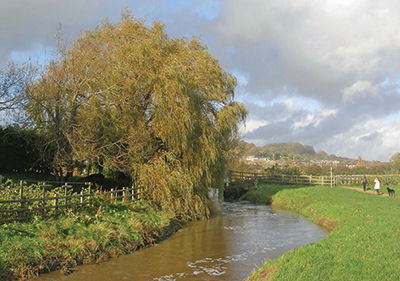
Willow trees are a familiar sight along river banks in this country, especially the weeping willow with its graceful, pendulous branches reaching down to the water below. As well as enhancing our countryside, the willow has been generous in providing us with useful materials, including wood for making cricket bats and double basses, and rods for basket making. But did you know that the willow also gave us aspirin, one of the world’s most popular drugs?
The bitter taste of willow bark
One day in the summer of 1758, the Rev. Edward Stone, an Oxfordshire clergyman, took a piece of bark from a willow tree growing by a small stream in Chipping Norton and chewed it. We shall never know why he did this but after chewing the bark, he remarked on its “extraordinary bitterness”. The taste reminded him of the similarly bitter bark of the South American cinchona tree, imported and used to treat the ague, most likely a form of malaria and endemic to the UK at the time. The taste similarity made Stone wonder whether willow bark might also combat the ague so he gathered some willow twigs, dried them and ground them to a powder. His hunch was right because when he administered the powder to ague sufferers it alleviated their symptoms (fever, temperature, aching limbs, and headache). His observations were published by the Royal Society in 1763 and so began the modern age of the medicinal use of willow bark.
In fact, extracts of willow had been used for thousands of years for pain relief with some of the first written references found as early as 3000BC in Sumerian and ancient Egyptian cultures. Use continued at least until the first few centuries AD in Greek and Roman civilisations. After that records are less clear although the use of willow bark lived on in folk medicine.
The rise of science in the 19th century
The 19th century was a time of huge political, intellectual and industrial ferment and with this came an increased emphasis on science. Huge strides were made in isolating the active principles from plant-derived remedies such as opium and eventually the focus moved to willow bark, although progress was very slow. Initially, a partially purified extract of willow bark (salicin) was obtained but by 1838 an acid was isolated and christened salicylic acid. These salicylates, as they are called, were named after the Latin for willow, Salix. At about the same time, scientists in Berlin purified a substance from the plant meadowsweet, known for its beneficial effects on toothache and rheumatism. This also turned out to be salicylic acid and the isolation of the same substance from unrelated plant sources underlined its potential importance. Further progress remained slow but by the end of the 19th century several controlled trials had shown that salicylates were effective treatments for rheumatism reducing symptoms of fever, inflammation and pain.
The birth of aspirin
There was a major problem with the salicylates, especially salicylic acid, when used for pain relief; they caused a gastric irritation and this hindered their widespread acceptance in medicine. Several attempts were made to modify the chemical structure in the hope that this might reduce these side effects. This was achieved most efficiently by the Bayer Company in Germany and the product, acetyl salicylic acid, was found to be an excellent pain reliever, free of gastric side effects in most patients. Bayer named their new drug aspirin after the old botanical name of meadowsweet, Spiraea. Aspirin was launched in 1899 and gradually gained in popularity with doctors and with patients.
As more and more people used aspirin, however, it emerged that the drug was not entirely free of side effects. For a small proportion of patients it led to severe gastric irritation and bleeding caused by small insoluble fragments of the drug lodging in the stomach wall. A new soluble formulation of aspirin overcame this problem and by the 1950s, aspirin was the undisputed leader in the over-the-counter pain relief market.
New pain killers and new uses for aspirin
In the 1950s and 1960s two new analgesic drugs, paracetamol and ibuprofen, entered the market and began to challenge aspirin’s supremacy. There was little to choose between aspirin and the new drugs in terms of pain relief and sales of aspirin dipped substantially. Indeed aspirin might have disappeared altogether had not new information emerged about its therapeutic effects.
In the 1970s, controlled trials showed that regular consumption of aspirin reduced the incidence of heart attack and stroke by preventing formation of blood clots. Based on this work, it is now recommended that patients who are at risk for heart disease (typically if they have already had one heart attack or certain kinds of stroke) should take a daily low dose of aspirin. This should, however, be undertaken only after advice from a doctor; there are significant risks to taking aspirin on a daily basis and lifestyle changes may also be very important. More recently, regular aspirin has been found to reduce substantially the occurrence of cancers of the bowel and oesophagus. Amazingly, aspirin is now known to attack two of the world’s major diseases, heart disease and cancer.
With these new and unexpected therapeutic effects, sales of aspirin have picked up again and it is now one of the most widely used drugs in the world. 35,000 metric tonnes are produced annually, equivalent to 100 billion standard tablets.
Little did the Rev. Stone know when he sank his teeth in to a rough piece of willow bark in 1758 that the “extraordinary bitterness” he experienced would lead 250 years later to one of the most popular and useful drugs in the world—a true wonder drug.




